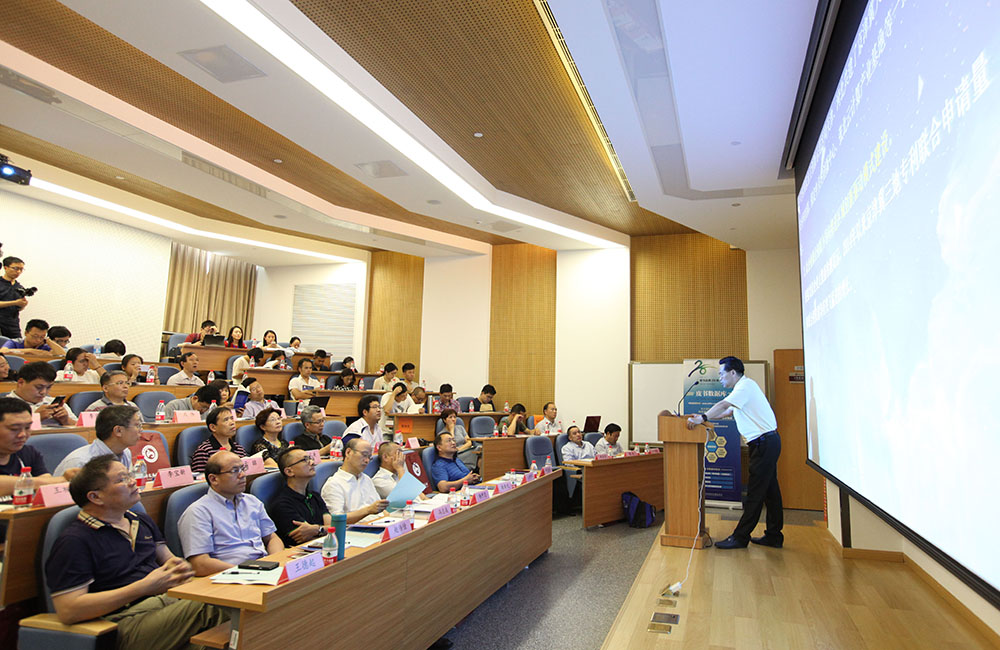2017 Beijing-Tianjin-Hebei Bluebook Released at CUEB

The launching ceremony saw the presence of Mr. Yang Kaizhong, Vice President of CUEB, Mr. Xie Shouguang, President of SSAP and Miss Yun Wei, chief editor of economics with SSAP. Leaders and experts from various communities in the region along with 30 media outlets, including the People's Daily, Xinhua News Agency and Economic Daily, and CUEB teachers and students joined in the event, which was anchored by Mr. An Shuwei, professor with the CUEB School of Urban Economy and Public Administration.
Zhu Heliang, chief editor of the bluebook, introduced the theme, framework and perspectives of the compilation at the beginning of the press conference. Mr. Zhu, who is also the director of CUEB scientific research division, pointed out that fresh advancement has been made in the synergistic development of Beijing, Tianjin and Hebei. At the moment, we are further phasing out Beijing’s noncapital functions, such as industries, higher education and healthcare. With Xiongan New Area poised to be the accommodator of the non-capital functions, we will see urban problems resolved, regional cooperation in ecological protection strengthened and collaborative innovation elevated.
The editor in chief said that Beijing is in the axis with Tianjin and Hebei catching up in terms of development index. The coordinated development enjoyed steady progress as the according index is quickly ticking up. Beijing is the top scorer in ecological conservation index with Tianjin being the most improved player and Hebei province as the most effective user of resources. Better demographic index is across the board. With regards to enterprise index, Beijing enjoys the strongest overall strength while Tianjin takes the lead in R&D conversion and Hebei is dominant in trade logistics. Nevertheless, we’re still faced with daunting challenges, including the absence of a sharing scheme, incomplete supporting policies, a weak mechanism for ecological compensation, large industrial gaps and excessive administration.
Lin Lin, director of Planning and Construction Department with Administrative Committee of Zhongguancun Chaoyang Science Park, announced the synergy index. He believed that the fast rising figure showcased a narrowing gap of development in the three areas. The synergy performance data, however, called for more efforts in this direction.
The enterprise development index was released by Li Yu, chief data scientist with the Big Data Research Center of Beijing-Tianjin-Hebei. He stressed that concerted industrial development has made remarkable progress and that joint innovation in the region became closer more than ever. Haidian District, Xicheng District, Chaoyang District, Dongcheng District and Binhai New Area are the top 5 regions in terms of enterprise overall strength.
Renmin University Prof.Zhang Yaojun announced the Demographic Development Index, according to which all 13(“2+11”) cities in the region have recorded growth with Beijing, Tianjin and Shijiazhuang remaining the highest. It’s urgent for Baoding, the city where the Xiongan New Area is located, to make speedy improvement.
Prof. Zhang Jie, also with Renmin University, argued that intrinsic conflicts and contradictions are becoming increasingly prominent in the transition from old to new drivers of growth. As such, the ultimate goal of the concerted industrial development in the region needs to be more clear and elaborate. Common development must be accomplished through upgraded administrative system and more vigorous markets.
The ecological advancement index released by CUEB professor Zhang Guixiang is a promising sign that the ecological conservation in the region is on the track with Beijing leading the charge followed by Tianjin and Hebei.
Other information concerning the progress made and steps taken by Beijing, Tianjin and Hebei in advancing the coordinated development was made public by Duan Xia, acting dean of Academy of Metropolis Economics and Social Development of CUEB, Dr. Wang Shenyan with the Party School of Tianjin Municipal Committee of CPC, and Prof. Li Baoxin with Hebei University of Economics and Business.
